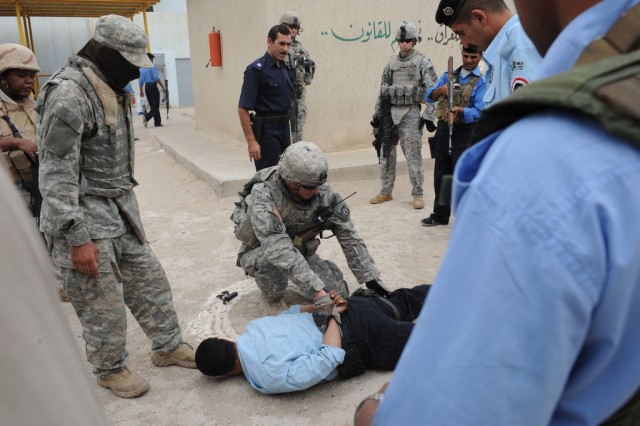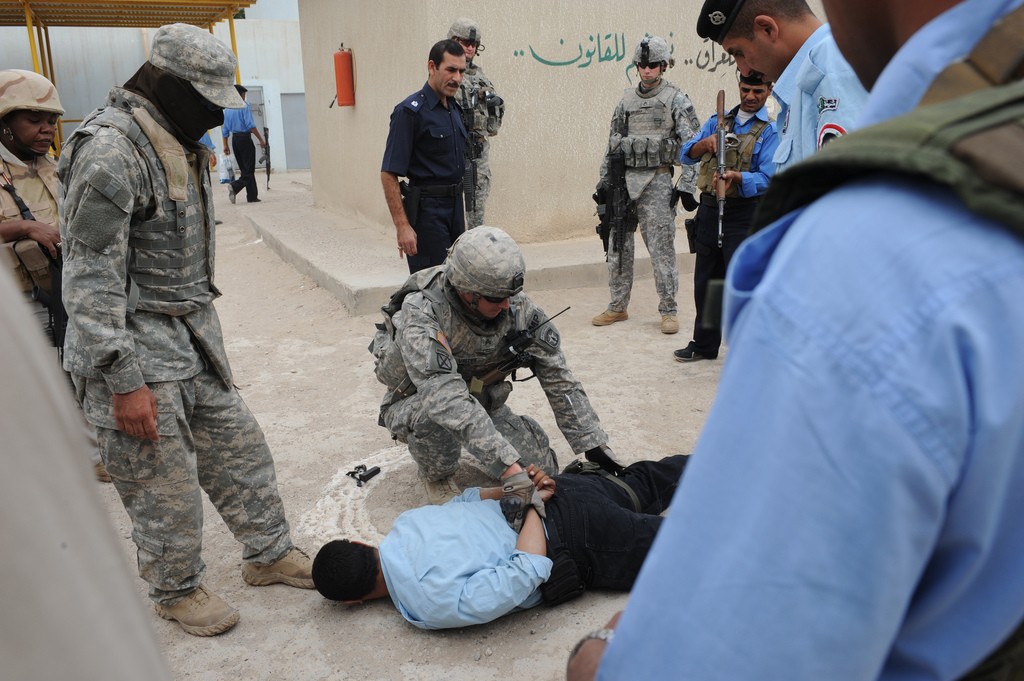Forensic science involves the application of a broad spectrum of sciences to establish factual information and answer questions of interest based on forensic material.
Expeditionary forensics refers to the use of forensics to establish facts that the combatant commander can use to determine sources of insurgent arms, ammunition, and explosives; drive intelligence analysis and subsequent targeting for combat operations; change force protection measures; identify human remains; and prosecute detainees in a court of law.
Intelligence operations benefit from the rapid forensic exploitation of information, items, and sensitive sites, enabling U.S. and coalition forces to eliminate threats and capture, prosecute, or kill enemies.
The War on Terrorism and associated military operations in Iraq and Afghanistan have produced an operational need to expand the use of forensics beyond the historical judicial, intelligence, and medical realms.
A joint expeditionary forensic facility (JEFF) lab was established in Iraq in December 2006 to address the high number of sniper attacks throughout the Iraqi theater of operations (ITO). At that time, the countersniper lab was capable of two things-latent printing and firearm/tool marking.
The capability for deoxyribonucleic acid (DNA) analysis existed only in the International Zone, which supported a task force that examined extrajudicial killings. When that task force was disbanded, the DNA analysis capability was moved to the JEFF countersniper lab. In late 2007, Lieutenant General Raymond Odierno (then the commander of the Multinational Corps-Iraq) directed the establishment of JEFF forensic labs in each major division area of operation.
The original countersniper lab, now known as the JEFF 3 lab, accepted its fi rst piece of evidence-a Dragunov sniper rifle-on 30 December 2006. Since then, the lab has processed more than 1,800 cases, resulting in over 150 biometric identifications. Today, the JEFF 3 mission is to "conduct firearm/tool mark, latent print, and DNA forensic analysis in general support of U.S. and coalition forces in the entire ITO in order to exploit biometric and forensic evidence resulting in the
killing, capturing, or prosecution of anticoalition forces."
The JEFF 3 lab, which is under the administrative control of the 733d Military Police Battalion (U.S. Army Criminal Investigation Command [USACIDC] [commonly referred to as the "CID"]/Forensic Exploitation Battalion), provides general support to the Multinational Corps-Iraq, including more than twenty brigade combat teams and various combined joint special operations task force elements. The lab also has close working relationships with weapon intelligence teams, explosive ordnance disposal units, law enforcement professionals, the U.S. Special Operations Command, the CID, theater internment facilities, and detainee holding areas. All of the analysts, examiners, and technicians assigned to the lab are civilians who are specialists in their specific fields and have volunteered for this expeditionary mission.
The JEFF 3 lab processes all evidence related to nonimprovised explosive devices, including evidence from sniper attacks, insurgent and terrorist torture houses, various complex attacks on coalition forces, caches, enemy killed-in-action confirmation of high-value individuals on
targeted raids, highly sensitive political cases, and select CID cases. In addition, partnerships with the Combined Explosive Exploitation Cell and document and media exploitation labs allow the co-processing of cases where additional laboratory analysis is required.
The processing of material at JEFF 3 consists of several steps, beginning with the collection of evidence following an incident such as a planned site exploitation mission or a response resulting from a routine patrol. The evidence is transported to the lab through a variety of means, normally arriving within hours but can be up to a week after an incident, depending on the urgency of the
analysis and the needs of the unit. The most critical step of the process is triage, which begins when evidence arrives at the lab. Triage is the process used to determine the best method of supporting unit requirements to capture, prosecute, or kill the enemy through forensic analysis. It allows the lab to best prioritize valuable resources by sorting cases into three
distinct categories:
Aca,!Ac Expedite. Expedite cases have resulted in an injury to or death of a coalition soldier.
Aca,!Ac Priority. Priority cases are time-sensitive in nature and are often associated with the release of a detainee or an at-large individual potentially targeted by a unit.
Aca,!Ac Routine. Routine submissions are placed into the queue for processing but do not have the same
sense of urgency as expedite or priority cases.
Triage is conducted by the evidence custodian or case file manager (alternate evidence custodian).
Units that submit evidence for analysis must provide documentation of the incident (a significant activity report or a description of the "who, what, when, where, why, and how"), detailing how forensic analysis of the evidence can be expected to link the item or person to a specific event.
Triage also involves establishing a chain of custody if it has not already been established by the submitting unit. The submitting unit completes a Department of the Army (DA) Form 4137, Evidence/Property Custody Document; Department of Defense (DD) Form 2922, Forensic Laboratory Examination Request; and labtracking and unit information sheets. The case file manager establishes a case file, and the evidence is properly secured in the evidence room. A record of the evidence is entered into the evidence ledger, evidence tracker program, and
lab matrix.
The ability to provide time-sensitive, actionable intelligence to the combatant commander is the most important aspect of the JEFF 3 lab. The turnaround time for analysis in an expedited latent print and firearm/tool mark case is a couple of hours to a day, depending on the number of items submitted. Expedited DNA processing takes twenty-one to twenty-four hours to complete. These short processing times allow units maximum flexibility for targeting or prosecution. JEFF 3 lab employees are allowed to provide expert testimony in the central criminal courts of Iraq.
The Latent Print Section is very successful at recovering and analyzing prints from a variety of porous and nonporous evidence using items such as 1,8-diazafluoren- 9-one (DFO), ninhydrin, physical developer, superglue, powder, Reflected Ultraviolet Imaging Systems, and dye stain lasers.
The section has assisted with cases involving theater internment facility detainees, sniper incidents,
anticoalition force threat letters, and al-Qaida intelligence documents.
Firearm/tool mark analysis has also proven valuable.
State-of-the-art technology enables the Firearm/Tool Mark Section to perform fi rearm identification and function;ammunition identification and examination; microscopic comparisons of fired bullets, cartridge cases, and tool marks; serial number restoration; physical fracture matching; distance determination; and trajectory analyses. Most notable is the section's ability to match explosively formed projectile cones and liners through tool mark analysis and to link several sniper cases in which coalition members were killed. These capabilities have been used to assist in several high-profile, escalation-of-force incidents involving coalition forces and local Iraqis and have also played a critical role in several fratricide cases.
The DNA Section conducts nuclear and y-chromosomal testing. DNA profiles have been recovered from an amazing list of items-many of which are not normally considered viable candidates for DNA analysis. These analyses have proven invaluable in assisting with "duty status, whereabouts unknown" cases in which DNA is obtained from coalition members' personal effects such as shirts, socks, and boots. The DNA analysis capability is used extensively in support of U.S. Special Operations Command units.
The desired end state of any analysis- latent print, DNA, or fi rearm/tool mark- is the tying of forensic evidence to an individual or incident. In the event of a match, or "hit," the National Ground Intelligence Center case manager immediately notifies the submitting unit. This immediate feedback provides the unit with expedient, actionable intelligence to target or prosecute. If
the subject of the analysis is detained, a lab law enforcement professional prepares an evidence/prosecution packet for potential use in the central criminal courts of Iraq. Lab law enforcement professionals also provide a critical link to all maneuver units in the ITO; commanders rely on these evidence experts for guidance.
JEFF 3 defines success by the ability to provide units with expedient answers to target or prosecute the enemy. There has been nearly a 150 percent increase in caseload at the lab over the past six months, and a record number of matches has been achieved in the last two months. One of the most important impacts of forensic analysis on the War on Terrorism is the ability to prevent another incident like that of 9/11. The thousands of matches made in Iraq have allowed us to interdict individuals who want to cause harm to Americans. But, today's mission of saving Soldiers' lives in Iraq is of the greatest significance.
The road ahead will be a busy one for the JEFF 3 lab. As the ITO continues to evolve toward the rule of law, evidentiary detainments and prosecutions will play an increasingly crucial role in developing a stable future for Iraq. There will likely be an increase in exploitable evidence used solely for prosecution as opposed to targeting. The JEFF 3 lab eagerly awaits the challenge.


Social Sharing